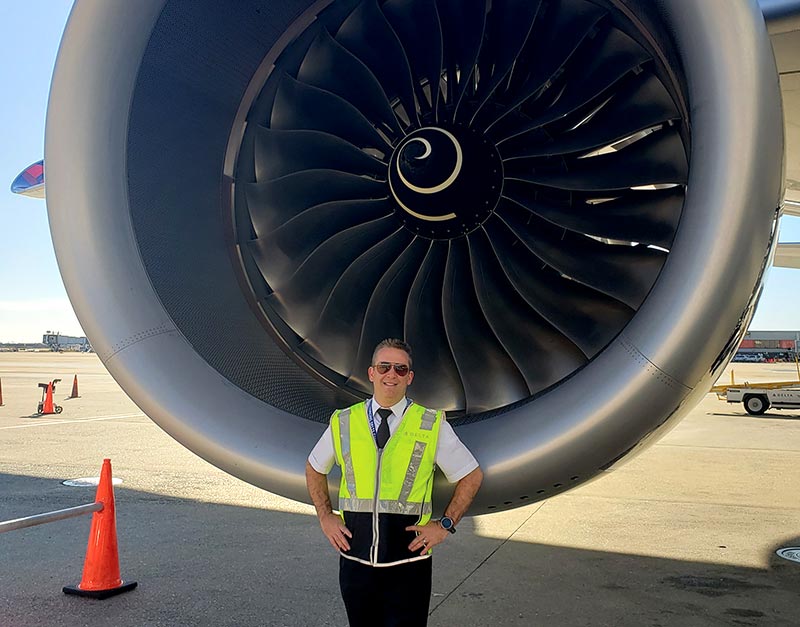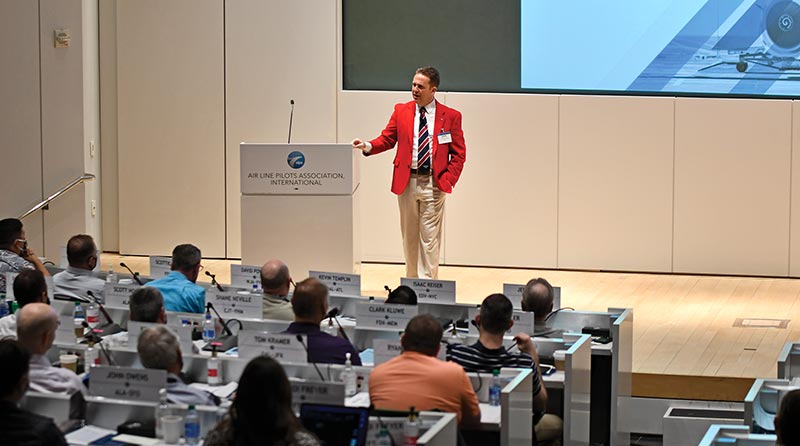Five Questions For ALPA’s Leadership Committee Chair
By Christopher Freeze, Senior Aviation Technical Writer

Capt. Mark Lockwood (Delta), ALPA's Leadership Committee chair, in front of an A350's Rolls-Royce engine.
Editor’s note: This column showcases the efforts of a cross section of ALPA pilots who volunteer their time and talents to advocate for the union’s priorities and the cadre of knowledgeable and passionate staff specialists who support them.
The Association’s Leadership Committee oversees efforts to ensure that elected pilot leaders who step up to volunteer their time receive appropriate training and have access to the resources they need to best represent their fellow pilots.
Air Line Pilot sat down with F/O Mark Lockwood (Delta), the Leadership Committee chair, to learn more about the pilot who leads the Association’s efforts to support its elected pilot leaders.
Air Line Pilot:
1. How did you get into aviation/flying?
F/O Mark Lockwood: I lived in Wapakoneta, Ohio—best known as the hometown of Neil Armstrong, the first person to walk on the moon—until I was grade-school aged. The town has a small museum dedicated to him. As a young boy, my mother would take me to the museum quite often, and I attribute my affinity for all things aerospace to those visits during my formative years.
In my early teens, I took my first flight in a light airplane, a Cessna 182, with a gentleman from my church, and like many of us I was hooked as the wheels first left the ground. Unbeknownst to me, my dad had earned his private pilot’s license in the 1970s and had let it lapse after my siblings and I were born. My interest in aviation rekindled his interest, and he purchased a Piper Cherokee 160 and relearned how to fly.
Flying with my dad was fun, but I wanted to learn how to fly myself. However, I was only in eighth grade at this point. Trying to dissuade me, my parents made me a deal. If I took a private pilot ground school and passed the FAA written exam, they’d let me start lessons. Their plan backfired when I passed the written exam the summer before I started high school!
By this time, my dad had upgraded airplanes and now had an Aerospatiale Tobago TB-10. I started taking lessons in that airplane at 15 years old and met many of the young pilot milestones: I soloed at 16 and earned my private pilot certificate at 17—followed by an instrument rating and commercial certificate before I started college.
I went to Embry-Riddle Aeronautical University in Daytona Beach, Fla., and graduated in three years while working as a flight instructor. Up until this point, all my plans were coming together fairly well. However, the airline industry became overtaken by events and my career didn’t continue as smoothly as it had started. I graduated in spring 2002 in the aftermath of the 9/11 terrorist attacks. I experienced my first furlough when employed as a flight instructor at Embry-Riddle. I then went to work for Regional Airline Academy, a local flight school, running its airline transition program until finally getting hired by Air Wisconsin in 2005.
I worked for Air Wisconsin for more than 10 years but was downgraded and displaced during the 2008 recession. In 2016, 14 years after graduating from college, I was hired by Delta Air Lines, and I’m currently an A350 first officer based in Detroit, Mich.
2. How did you first become involved with ALPA work?
Lockwood: Shortly after my probationary year at Air Wisconsin, I was elected first officer rep for the Philadelphia, Pa., Local Council. I ran for the position because I really didn’t understand what unions did and, frankly, was antiunion at that point in my early career. I knew ALPA took about 2 percent of my income and I received a glossy magazine, but I didn’t know much else. I wanted to learn more. Now, 17 years into my airline career and having served in various union positions, I completely understand what a union does, the value of ALPA membership, and why connecting with members through the magazine and all the other communication channels is important.
3. What are your roles and responsibilities as ALPA’s Leadership Committee chair?
Lockwood: The committee hosts an annual three-day Leadership Training Conference for newly elected reps. It’s a common misconception that this conference is to train newly elected reps to be leaders. This isn’t the case. Folks who’ve run for and have been elected to rep positions are already leaders. The goal of the conference is to help these leaders understand the roles and responsibilities that they now have and the resources available to them.
Preparing for and running this conference is my primary responsibility. Each year, my committee members meet with key staff in advance to develop the training curriculum, using new techniques to deliver the information and adding activities based on pilot feedback from previous conference evaluations. I also attend other ALPA gatherings like the Executive Board, Board of Directors (BOD), and National Committee Chairs meetings to ensure that master executive council (MEC) officers and other pilot leaders know about the support available from the committee. This support includes tailored orientations for new MEC officers—a growing area of training as pilot groups experience leadership turnover—and leadership onboarding for temporary reps of new pilot groups joining ALPA.
Additionally, the current ALPA strategic plan tasks the Leadership Committee with developing the training for newly elected national officers and executive vice presidents. This training is scheduled to take place following the BOD meeting in October.

Lockwood addresses attendees of this year's Leadership Training Conference.
4. How do ALPA national and staff help you achieve your goals?
Lockwood: I frequently interact with ALPA’s national officers and staff, and all are incredibly helpful. I was appointed the committee chair at the beginning of 2021 when the previous long-serving chair, Capt. David Farmer (Delta), retired. This was a particularly challenging time: my first conference as chair was a virtual one! The Strategic Member Development and Resources (SMD&R) Department staff was instrumental in coordinating all the moving pieces required to hold our “pandemic” training conference and the subsequent online training modules. I’m also particularly grateful to all the presenters who adjusted to a virtual environment in 2021. As COVID case counts allowed, we held an abbreviated Leadership Training Conference in person last September to continue the new reps’ training, and SMD&R came through with the logistics and preparation to provide onsite training with a few virtual presenters. I’m very pleased that we successfully held our traditional in-person training conference last month that incorporated some new segments and activities to better support our new reps.
5. What advice would you give to new pilots who want to get involved with ALPA?
Lockwood: One of the great things about ALPA service is that there’s a place for virtually any person’s interest, talents, and desired time commitment. Regardless of how an ALPA volunteer serves, they can rest assured that they’re working for the benefit of their fellow pilots and their careers. There are very few roles in the working world for which one can say that.
ALPA leaders are always looking for talented individuals to serve the group. I would suggest thinking about areas you’re interested in or perhaps trained in. Reach out to your reps or another person who does ALPA work in your pilot group and see where you might fit in to the larger scheme. There may be some roles that you’re not aware of.
Speaking personally, the work I’ve done through ALPA has been some of the most rewarding of my career. I’ve learned a lot about my profession and myself through volunteering with the Association. I’ve had the opportunity to interact with very dedicated, talented, and knowledgeable pilots and staff. There’s a lot of work that’s being done every day for pilots by some of the best people I know. I feel truly blessed to have the opportunity to serve my fellow pilots.

